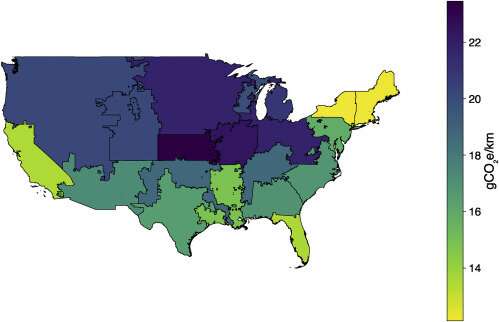GHG emissions per km from a drone package delivery with a 0.5-kg payload and 2-km one-way delivery distance (4-km round trip), according to the sub-region’s non-baseload electricity grid carbon intensity. Credit: Patterns (2022). DOI: 10.1016/j.patter.2022.100569
A team of researchers at Carnegie Mellon University has found that drones carrying parcels use much less energy per parcel than diesel delivery trucks. In their paper published in the journal Patterns, the group described their tests of drones carrying packages and how they compared with trucks.
As scientists the world over look to find ways to reduce carbon emissions, some have turned to the freight sector—a lot of cargo is moved from where it is made or sold to customer destination sites. Much of the carbon footprint is due to airplanes and ships that carry goods long distance but a lot is also due to the "last mile" as it is known in the delivery business—the last leg of delivery. In this new effort, the researchers looked at the delivery of single small packages to a single destination—such as a customer's home. They wanted to know if a drone carrying a package that last leg used less energy than a person driving a truck, which typically runs on diesel fuel.
To find out, the researchers used small quadcopter drones to carry 0.5-kilogram packages various distances at speeds ranging from 4 to 12 meters per second. They then used data from the flights to calculate how much electricity was used by the batteries they held. Then, they calculated how much electricity was needed to charge the batteries and then how much the electricity cost and its source (whether it was generated from coal, for example or a windmill farm). The team then compared their calculations to those that have already been calculated for diesel delivery trucks. In so doing, they found that for single delivery of a package, drone delivery has a much smaller carbon footprint. More specifically, they found that a drone delivery accounted for 84% less greenhouse gas emissions than a diesel truck—it also used 94% less energy.
The researchers note that carbon savings depended very much on where in the country the electricity used to charge the drone batteries was produced. It was much higher, for example, in areas where electricity is generated by coal fired power plants, than in places where renewable sources such as hydropower are more prevalent. They suggest that in any case, switching to drones for single package delivery could result in significant reductions in energy used and indirectly in carbon emissions.
More information: Thiago A. Rodrigues et al, Drone flight data reveal energy and greenhouse gas emissions savings for very small package delivery, Patterns (2022). DOI: 10.1016/j.patter.2022.100569
Journal information: Patterns
© 2022 Science X Network
























